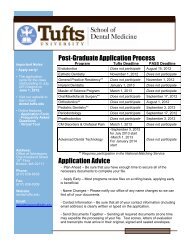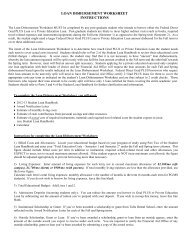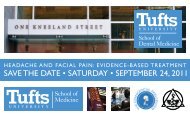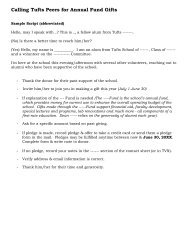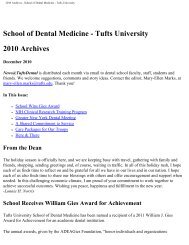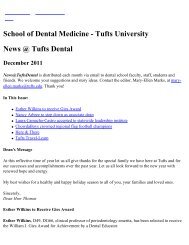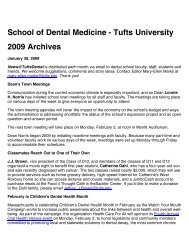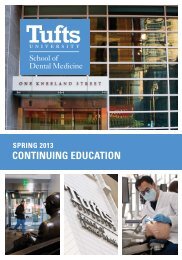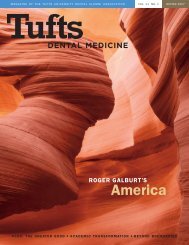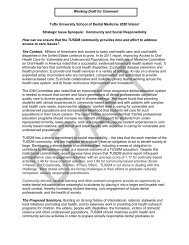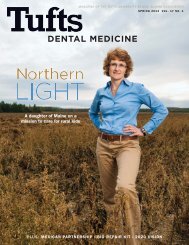Spring 2010 - Tufts University School of Dental Medicine
Spring 2010 - Tufts University School of Dental Medicine
Spring 2010 - Tufts University School of Dental Medicine
You also want an ePaper? Increase the reach of your titles
YUMPU automatically turns print PDFs into web optimized ePapers that Google loves.
Maybe it’s a product <strong>of</strong> our 24/7 lifestyles,<br />
but for many Americans, quality<br />
sleep is getting harder to come by. In 2008,<br />
the National Sleep Foundation surveyed<br />
1,000 people for its Sleep in America Poll<br />
and found that 65 percent <strong>of</strong> them reported<br />
having a hard time falling or staying asleep<br />
more than once a week.<br />
Though sleep medicine is a growing<br />
field, fewer than 40,000 <strong>of</strong> the nation’s<br />
750,000 physicians belong to the American<br />
Academy <strong>of</strong> Sleep <strong>Medicine</strong>. That’s not even<br />
close to enough health-care providers to<br />
handle the estimated 50 million to 70 million<br />
Americans who are living with one or<br />
more <strong>of</strong> the 85 medically recognized chronic<br />
sleep disorders—including obstructive<br />
sleep apnea—that result in overwhelming<br />
daytime drowsiness. Untreated sleep disorders<br />
can lead to potentially deadly health<br />
problems, not to mention the hazards the<br />
chronically sleepy pose on the road and in<br />
the workplace.<br />
Now, <strong>Tufts</strong>’ new <strong>Dental</strong> Sleep <strong>Medicine</strong><br />
Program, the first university-level curriculum<br />
<strong>of</strong> its kind in the United States,<br />
is training dentists—with their expertise<br />
in oral anatomy, surgery and therapeutic<br />
appliances—to screen, diagnose and treat<br />
their patients who suffer from sleep disorders,<br />
primarily obstructive sleep apnea,<br />
a condition in which a patient literally<br />
stops breathing for 10 seconds or more.<br />
First <strong>of</strong>fered in fall 2009, the semester-long<br />
course <strong>of</strong>fers postgraduate dental students<br />
classroom instruction and clinical training<br />
in sleep medicine. Students participate in<br />
patient evaluations, observe sleep studies<br />
and assist with fitting and adjusting oral<br />
appliances designed to give their patients a<br />
good night’s sleep.<br />
“I applaud the educators at <strong>Tufts</strong> <strong>School</strong><br />
<strong>of</strong> <strong>Dental</strong> <strong>Medicine</strong> for the implementation<br />
<strong>of</strong> their <strong>Dental</strong> Sleep <strong>Medicine</strong> Program<br />
and hope that many dental schools will<br />
follow their lead,” said the president <strong>of</strong><br />
the American Academy <strong>of</strong> <strong>Dental</strong> Sleep<br />
<strong>Medicine</strong>, Jeffrey Pancer.<br />
The sleep medicine program is <strong>of</strong>fered<br />
as an elective to all 144 <strong>of</strong> <strong>Tufts</strong> <strong>Dental</strong><br />
<strong>School</strong>’s postgraduate students, and those<br />
in certain postgrad programs are required<br />
to take the course to earn certification in<br />
their specialties. “We didn’t want it to be a<br />
Percent Reporting Drowsy-Driving Experiences<br />
Driving a<br />
vehicle while<br />
feeling drowsy<br />
Dozed <strong>of</strong>f while at<br />
the wheel<br />
<strong>of</strong> a vehicle<br />
Had an accident<br />
because they<br />
dozed <strong>of</strong>f or were<br />
overly tired<br />
Percent Reporting Daytime Sleepiness<br />
A sizeable number <strong>of</strong> adults (37%) report that<br />
they are so sleepy during the day that it interferes<br />
with their activities a few days a month or more,<br />
and 16% experience this level <strong>of</strong> daytime<br />
sleepiness a few days a week or more.<br />
SOURCE: NATIONAL SLEEP FOUNDATION<br />
0% 20% 40% 60% 80% 100%<br />
Everyday/almost every day<br />
7%<br />
A few days a week<br />
9%<br />
separate program because we want [dental<br />
sleep medicine] to be involved in all aspects<br />
<strong>of</strong> dentistry,” says Noshir Mehta, DG73,<br />
DI77, pr<strong>of</strong>essor and chair <strong>of</strong> general dentistry<br />
and director <strong>of</strong> <strong>Tufts</strong>’ Crani<strong>of</strong>acial<br />
Pain, Headache and Sleep Center, which<br />
developed the program. “Ultimately, we’d<br />
like every postgraduate student to [take the<br />
course],” says Mehta.<br />
<strong>Tufts</strong> has incorporated sleep medicine<br />
and management <strong>of</strong> chronic facial pain<br />
into its D.M.D. program for several years<br />
now to provide students with the tools “to<br />
identify patients who should get tested,” says<br />
A few days a month<br />
20%<br />
1998<br />
1999<br />
2000<br />
2001<br />
2002<br />
Rarely/Never<br />
63%<br />
Leopoldo P. Correa, the course director and<br />
head <strong>of</strong> the school’s <strong>Dental</strong> Sleep <strong>Medicine</strong><br />
Section. Extending the curriculum to postgraduates<br />
preparing for specialty practice<br />
means “more students will gain the skills<br />
and in-depth experience they need to integrate<br />
dental sleep medicine into their practices,”<br />
he says.<br />
The most common sleep disorder is<br />
obstructive sleep apnea (OSA). Though figures<br />
vary, the National Sleep Foundation estimates<br />
that OSA afflicts more than 18 million<br />
18 tufts de ntal medicine sp r i n g 20 1 0



